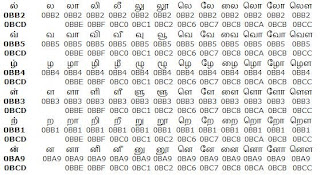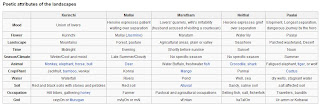 http://ta.wikipedia.org/
http://ta.wikipedia.org/Friday, November 19, 2010
Thursday, July 15, 2010
Tamil is an Oldest Classical Language





April 11, 2000
Statement on the Status of Tamil as a Classical Language
Professor Maraimalai has asked me to write regarding the position of Tamil as a classical language, and I am delighted to respond
to his request. I have been a Professor of Tamil at the University of California, Berkeley, since 1975 and am currently holder
of the Tamil Chair at that institution. My degree, which I received in 1970, is in Sanskrit, from Harvard, and my first
employment was as a Sanskrit professor at the University of Wisconsin, Madison, in 1969. Besides Tamil and Sanskrit, I know the
classical languages of Latin and Greek and have read extensively in their literatures in the original. I am also well-acquainted
with comparative linguistics and the literatures of modern Europe (I know Russian, German, and French and have read extensively
in those languages) as well as the literatures of modern India, which, with the exception of Tamil and some Malayalam, I have
read in translation. I have spent much time discussing Telugu literature and its tradition with V. Narayanarao, one of the
greatest living Telugu scholars, and so I know that tradition especially well. As a long-standing member of a South Asian
Studies department, I have also been exposed to the richness of both Hindi literature, and I have read in detail about Mahadevi
Varma, Tulsi, and Kabir. I have spent many years -- most of my life (since 1963) -- studying Sanskrit. I have read in the
original all of Kalidasa, Magha, and parts of Bharavi and Sri Harsa. I have also read in the original the fifth book of the Rig
Veda as well as many other sections, many of the Upanisads, most of the Mahabharata, the Kathasaritsagara, Adi Sankara’s works,
and many other works in Sanskrit.
I say this not because I wish to show my erudition, but rather to establish my fitness for judging whether a literature is
classical. Let me state unequivocally that, by any criteria one may choose, Tamil is one of the great classical literatures and
traditions of the world.
The reasons for this are many; let me consider them one by one.
First, Tamil is of considerable antiquity. It predates the literatures of other modern Indian languages by more than a thousand
years. Its oldest work, the Tolkappiyam,, contains parts that, judging from the earliest Tamil inscriptions, date back to about
200 BCE. The greatest works of ancient Tamil, the Sangam anthologies and the Pattuppattu, date to the first two centuries of
the current era. They are the first great secular body of poetry written in India, predating Kalidasa's works by two hundred
years.
Second, Tamil constitutes the only literary tradition indigenous to India that is not derived from Sanskrit. Indeed, its
literature arose before the influence of Sanskrit in the South became strong and so is qualitatively different from anything we
have in Sanskrit or other Indian languages. It has its own poetic theory, its own grammatical tradition, its own esthetics, and,
above all, a large body of literature that is quite unique. It shows a sort of Indian sensibility that is quite different from
anything in Sanskrit or other Indian languages, and it contains its own extremely rich and vast intellectual tradition.
Third, the quality of classical Tamil literature is such that it is fit to stand beside the great literatures of Sanskrit, Greek,
Latin, Chinese, Persian and Arabic. The subtlety and profundity of its works, their varied scope (Tamil is the only premodern
Indian literature to treat the subaltern extensively), and their universality qualify Tamil to stand as one of the great
classical traditions and literatures of the world. Everyone knows the Tirukkural, one of the world's greatest works on ethics;
but this is merely one of a myriad of major and extremely varied works that comprise the Tamil classical tradition. There is not
a facet of human existence that is not explored and illuminated by this great literature.
Finally, Tamil is one of the primary independent sources of modern Indian culture and tradition. I have written extensively on
the influence of a Southern tradition on the Sanskrit poetic tradition. But equally important, the great sacred works of Tamil
Hinduism, beginning with the Sangam Anthologies, have undergirded the development of modern Hinduism. Their ideas were taken
into the Bhagavata Purana and other texts (in Telugu and Kannada as well as Sanskrit), whence they spread all over India. Tamil
has its own works that are considered to be as sacred as the Vedas and that are recited alongside Vedic mantras in the great
Vaisnava temples of South India (such as Tirupati). And just as Sanskrit is the source of the modern Indo-Aryan languages,
classical Tamil is the source language of modern Tamil and Malayalam. As Sanskrit is the most conservative and least changed of
the Indo-Aryan languages, Tamil is the most conservative of the Dravidian languages, the touchstone that linguists must consult
to understand the nature and development of Dravidian.
In trying to discern why Tamil has not been recognized as a classical language, I can see only a political reason: there is a
fear that if Tamil is selected as a classical language, other Indian languages may claim similar status. This is an unnecessary
worry. I am well aware of the richness of the modern Indian languages -- I know that they are among the most fecund and
productive languages on earth, each having begotten a modern (and often medieval) literature that can stand with any of the
major literatures of the world. Yet none of them is a classical language. Like English and the other modern languages of
Europe (with the exception of Greek), they rose on preexisting traditions rather late and developed in the second millennium.
The fact that Greek is universally recognized as a classical language in Europe does not lead the French or the English to claim
classical status for their languages.
To qualify as a classical tradition, a language must fit several criteria: it should be ancient, it should be an independent
tradition that arose mostly on its own not as an offshoot of another tradition, and it must have a large and extremely rich body
of ancient literature. Unlike the other modern languages of India, Tamil meets each of these requirements. It is extremely old
(as old as Latin and older than Arabic); it arose as an entirely independent tradition, with almost no influence from Sanskrit or
other languages; and its ancient literature is indescribably vast and rich.
It seems strange to me that I should have to write an essay such as this claiming that Tamil is a classical literature --
it is akin to claiming that India is a great country or Hinduism is one of the world's great religions. The status of Tamil as
one of the great classical languages of the world is something that is patently obvious to anyone who knows the subject.
To deny that Tamil is a classical language is to deny a vital and central part of the greatness and richness of Indian culture.
(Signed:)
George L. Hart
Professor of Tamil
Chair in Tamil Studieshttp://www.ancientscripts.com/tamil.html
Monday, June 21, 2010
Tamil - Language and Culture - A brief introduction!
Welcome





http://www.projectmadurai.orgALL FOR ALWAYS GOOD-IF YOU BE GOOD & DO GOOD ! Education-Informal-Non-formal-It makes Human to fetch food for living. We earn a living by what we do,but we make a life by what we give. Educate. Education is a preparation for life.
Subscribe to:
Comments (Atom)












